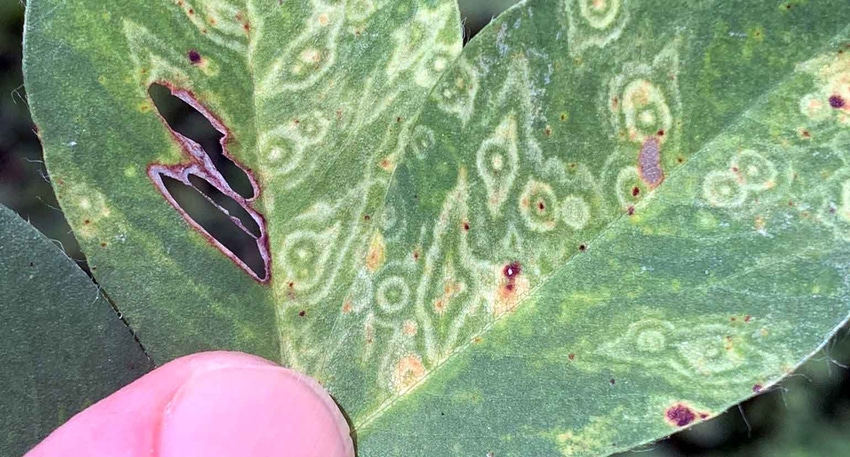
I put my truck in a ditch backing out of a cotton field. In doing so, I also blocked the northbound lane of Highway 19. One wouldn’t expect too much traffic at dawn, but I soon realized every logging truck in Georgia east of I-75 uses the road.
My mind shifted between hoping someone would stop and pull me out and wishing I had the chance to start the day over again. Of course, it was too late to change anything. The moment I put the front tire in the ditch was the moment the die was cast for the rest of my day, not unlike the reality for peanut growers with tomato spotted wilt disease when they close the furrow.
Tomato spotted wilt has been especially severe in southeastern peanut fields in 2022. Once the furrows were closed and the seeds covered, the growers had played most, if not all, of their “manage spotted wilt” cards as defined by Peanut Rx.
Finding abundant spotted wilt in your peanut fields in August is kind of like putting your truck in the ditch; what’s done is done. But worse yet, there is no fixing a spotted wilt, at least until next season. What CAN be done this season is learn what to do better in 2023 to avoid similar problems.
Theories?
We will never know why tomato spotted wilt has been so bad in 2022, however I do have several theories. The winter of 2021-2022 was unusually warm, and this could have created a situation that affected the thrips that transmit the virus. Because of warmer weather, growers may have been tempted to plant their peanuts in April when risk to tomato spotted wilt is higher.
For sake of convenience, some growers likely used a liquid insecticide to control thrips rather than the granular product Thimet. While there are a number of insecticides that growers can use to manage early season thrips, ONLY Thimet has been shown to consistently reduce risk to tomato spotted wilt. The benefit of Thimet for managing tomato spotted wilt has little to do with killing thrips and much more to do with the fact that this insecticide activates defense mechanisms in the plant that help to reduce threat to spotted wilt.
Good Samaritans did pull my truck out of the ditch; there are no “Good Samaritans” to rescue this year’s peanut crop from Tomato spotted wilt. Be prepared for next year with Peanut Rx.
Other Diseases
We’re well into the second half of the 2022 peanut and cotton seasons, damage from diseases and nematodes was readily evident in many fields.
Thick foliage trapped moisture and humidity deep in the canopy, prolonging leaf-wetness periods and providing the warm, moist environment perfect for fungal and bacterial pathogens to bring destruction. Cotton bolls are extremely sensitive to rot under these conditions; white mold and leaf spot diseases will continue to plague the peanut crop. The battle against diseases and nematodes began months ago; it becomes increasingly obvious now just who is “winning” the war.
No fungicide program will eliminate white mold from a field of peanuts, especially in fields where peanuts are planted in short rotations. Plants are often infected by the white mold fungus from sclerotia (fungal “seeds”) present in the soil around the roots and limbs. This infection results in damage to individual plants and is very difficult to manage. However, an effective fungicide program MUST stop the spread of the disease from one plant to the next.
Delayed Application
Where white mold is present but confined to spots the size of dinner plates, be assured that your fungicide program is working. Where white mold runs up and down the rows in extended streaks, there is a problem with your program. It may be that there was not timely rainfall or irrigation to move the fungicide from the leaves to the limbs and crowns of the plants.
Beaucoup mid-to-late season tomato spotted wilt disease can be confused for white mold/southern blight. For TSWV look for 1) familiar leaf patterns and rings, 2) dead taproot, 3) wilt, 4) bronzing/caramel color of immature pods, 5) lack of white fungus or sclerotia. UGA Extension pic.twitter.com/GxLXy8Ftkx
— Bob Kemerait (@bobkemerait) August 2, 2022
It may be that the fungicide application was delayed. It may be that the wrong fungicide was applied or that the right fungicide was applied at the wrong rate. Products like Elatus and Excalia bring new expectations for control of white mold, and Convoy and Umbra are long-time grower favorites for good reason. As we get later in the season, products like Provost Silver and Fontelis have both the efficacy and the label to finish out the crop.
Late summer is a tough month for cotton and peanut growers as they must be prepared to protect their crop from a number of important diseases and they must take the time to note problems in anticipation for next year.
About the Author(s)
You May Also Like






